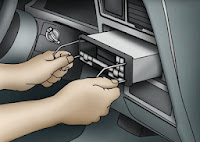 Wish to save some cash? Ever surprise if you could do a automotive stereo installation yourself? Yes, you'll do it yourself! Go ahead, pay that money on your hardware! Don’t spend it on labor. Besides, doing a automotive stereo installation yourself will be a terribly rewarding experience, not to say you'll learn a ton from it too. Nothing beats the sensation of seeing your “creation” in action, running smoothly and perfectly.
Wish to save some cash? Ever surprise if you could do a automotive stereo installation yourself? Yes, you'll do it yourself! Go ahead, pay that money on your hardware! Don’t spend it on labor. Besides, doing a automotive stereo installation yourself will be a terribly rewarding experience, not to say you'll learn a ton from it too. Nothing beats the sensation of seeing your “creation” in action, running smoothly and perfectly.But be very careful, you actually won’t want to wreck your expensive hardware. Well, most automobile audio hardware are not any-brainers to install, you’d notice that most of the time the elements have specially shaped sockets and slots etc. and would solely fit where it’s presupposed to be put in. Still, it’s best to proceed methodically.
In a car stereo installation, you have to see what kind of rig you’re going to place into your vehicle. If you’re a beginner, it’s best you do a automotive stereo installation if it’s simply a straightforward system. You could need to depart the difficult stuff to the professionals, like putting in delicate equipment like LCD panels, motorized parts etc. particularly if it requires the creation of custom panels and such.
Head units are one in all the best to try to to in a automobile stereo installation. Fortunately, most units follow the same size standards (DIN). In several cars, once the factory radio is removed the aftermarket radio will work in the hole. In several other cars, a kit is required if the factory hole is just too huge, or not deep enough. In some cases the dash has got to be cut. Any car stereo store should have kits required for installation.
There are 2 types of mounting in an exceedingly automotive stereo installation. ISO mounting is when the radio will be screwed to existing factory radio brackets, such as in most Japanese cars. Ring mounting is when an aftermarket radio comes with a metal ring that gets mounted to the factory radio hole or aftermarket kit via bendable tabs. In many cars, dash and trim rings need to be filed to enlarge the radio hole. Once the ring is installed, the radio slides in and is held by snaps. In most cases, special tools are needed to remove the radio.
Speakers are terribly important during a automotive stereo installation. No matter how expensive your speakers are, if they're not properly installed, the sound can not be up to par.
In an exceedingly simple automobile stereo installation, you’ll probably be using speakers that work into a factory location. Just build sure there are not any gaps or holes. Sometimes building a wood or fiberglass baffle helps scale back holes and gives you a lot of better sound. But continuously be careful when using power tools around speakers. Automotive stereo installation warranties usually do not cover holes in speakers.
For unconventional speaker locations, generally metal needs to be cut. You might wish to leave this to the professionals, tools like plasma cutters and pneumatics drills are needed. But if you’re going to insist, a try of metal snips (left and right cut) will do.
A automobile stereo installation has to put up with vibrations and alternative noise sources in its environment. Even though it's impossible to eliminate these fully, there are products that will greatly decrease the noise and rattling, notably on non-luxury cars. Liners, sprays and adhesive strips and even carpeting applied onto the panels can build a world of difference.
No comments:
Post a Comment